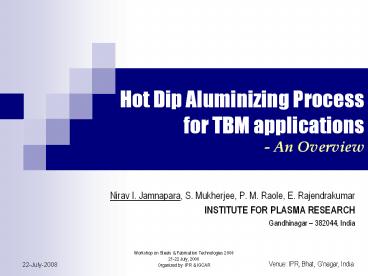Workshop on Steels - PowerPoint PPT Presentation
1 / 23
Title:
Workshop on Steels
Description:
Targeted Microstructures ... Microstructure of hot dipped surface ... Microstructure after heat treatment. Heat treatment at 1040 C/0.5 h 750 C/1 h ... – PowerPoint PPT presentation
Number of Views:127
Avg rating:3.0/5.0
Title: Workshop on Steels
1
Hot Dip Aluminizing Process for TBM
applications- An Overview
- Nirav I. Jamnapara, S. Mukherjee, P. M. Raole, E.
Rajendrakumar - INSTITUTE FOR PLASMA RESEARCH
- Gandhinagar 382044, India
2
About LLCB
- Solid Liquid Breeder Concept
- Li2TiO3 pebbles as solid breeder Pb-17Li
Eutectic as liquid breeder.
Fig 1 Open view of LLCB TBM
3
Schematic
450-900 ?C
460 ?C PbLi out
325 ?C PbLi in
2
4
Environment Challenges
- Liquid Pb-17Li _at_ 1.2 MPa, 325-460 ?C, 0.5-1 m/s
velocities 1 Hot Corrosion-erosion - T generation in CB Pb-Li circuits 1
- Tritium permeation through FMS
- Thermal Cycles 1
- MHD effects 1 Insulation needed
5
Why coating?
Fig 3 T permeation into coolant from Pb-17Li
blanket by Reiter 2
Fig 4 Permeability of several metals by P.S.
Korinko 3
Crsn
6
Ideal Coating Should
- Protect FMS against corrosion from Pb-17Li (gt
10,000 hrs) 5, 6 - Resist Tritium permeation through FMS (PRF gt 75
in Pb-17Li conditions) 4 - Maintain thermal compatibility (?)
- be Electrically insulating (to resist MHD
effects) - not affect heat transfer
- be easy to apply on substrates
7
Candidate coatings
8
Why Aluminide coating?
- Good resistance to T permeation
- Good corrosion resistance of FMS against liquid
Pb-Li (480 550 ?C) - Thermally compatible
- Electrically Insulating top layer (Al2O3)
- Volume resistivity 0.01 ? m
- EU Fusion Technology Program has considered
aluminide coatings as reference coating (HDA
CVD) as tritium permeation barriers. - Ref 09 J. Konys et. al., FZK Germany
9
Comparison
10
Why Hot Dip Aluminizing?
- Aluminizing possible by solid, liquid gas
processing 3 - Better PRFs with H2 as compared to CVD (J. Konys
FZK, Germany, 4) - Ease of processing complex geometries
- Scalable
- Adherent alumina by oxidation of surface
11
Targeted Aluminide Coating
- Intermetallic Fe-Al Al2O3
1-10 ?m Al2O3 (for resistance to corrosion, MHD
and Erosion)
150-180 ?m Intermetallic Fe-Al (for Tritium
Permeation Resistance)
Ref J. Konys et. al., FZK 4,5
12
Targeted Microstructures
Parameters for hot dipping temperature at 700C
and dipping time of 30 s
Microstructure of hot dipped surface
Microstructure after heat treatment
Al
Fe2Al5
F82H-mod.
The alloyed surface layer consists of brittle
Fe2Al5, covered by solidified Al
Heat treatment at 1040C/0.5 h 750C/1 h and an
applied pressure of gt250 bar (HIPing) reduces
porosity and transforms the brittle Fe2Al5-phase
into the more ductile phases FeAl and ?-Fe(Al)
Ref J. Konys et. al., FZK 4,5
13
HDA Setup - proposed
Al2O3 - crucible
Sample
Holding chamber with protective environment
Al-melt
Furnace
Melting chamber
Coating conditions 4,5 Temperature 700 750
C Melt Al or Al-Si (7-11 Si) Sample
dimensions 50 mm (l) x 30 mm (w) x 5 mm
14
HDA PROCESS
?
?
?
?
?
?
?
?
?
Steel sample (sheet or tube)
Grinding
Cleaning in acetone
Coating, aq. flux-solution
Pre-drying 100C
Glove-box (Ar-5H2)
Heat Treatment (Standard process)
?
?
?
Coated sample
?
?
HIP-process (advanced process)
Cleaning in water
?
?
Ref Voltrag, et. al. FZK 4,5
Hot-dip-aluminizing, 700C
15
Challenges
- Wettability of sample in Al melt
- Melt Composition (alloying, viz. Si)
- Surface Activation (fluxes etc.)
- Case composition tailored (Fe-Al)
- Post treatment (HIPing), dipping time, batch
composition - No porosities (HIPing), Case depth
- Adherent Al2O3 layer on top
- Plasma oxidation process
- Qualify for validation (performance related)
16
Plans for development
- Development of homogenous aluminized coating
after HDA - Generation of desired compositional profile by
heat treatment plasma oxidation - Hot Isostatic Pressing of aluminized samples
- (To be worked out in collaboration with other
national insitutes)
Hot Dip aluminizing 700 750 ?C
HIPing 1050 ?C, 250 Bar 1 hr
Validation
Plasma Oxidation H/T 1050 ?C
17
Validation
- Pb-17Li Loop testing
- H2 / T permeation
- Initially the sample will be tested for Hydrogen
permeation - Susequently the sample will be validated for
Tritium permeation in Pb-Li environment
Ref Schematic of Permeation testing facility at
ENEA, Italy
18
Present status
- Design generation of specs for furnace
- Fabrication installation of furnace
- Preliminary trials for HDA wettability
uniformity - Heat treatment optimization
- Characterization
- Hot Isostatic Pressing
- Validation
19
Thank You
20
References
- Design Description Document for Indian Lead
Lithium cooled ceramic breeder (LLCB) Blanket - G. W. Hollenberg et. al., Tritium / Hydrogen
Barrier Development, June 1994, 3rd Intl.
Symposium on Fusion Nuclear Technologies, LA,
California - P.S. Korinko et. al., Dev. of aluminide coatings
for Hydrogen isotope permeation resistance,
Tritium 2001, Tsukaba, Japan, 11-16 Nov, 2001 - J. Konys et. al., ITER TBM Project Meeting, UCLA,
Feb 23-25, 2004. - J. Konys et. al., J. Nucl. Mat. 367-370 (2007)
1144-1149 - H. Glasbrenner et. al., J. Nucl. Mat. 307-311
(2002) 1360-1363
BACK
21
Corrosion data
Ref W. Krauss et. al., Intl. workshop on breeder
blankets, Russia June, 2006
BACK
22
Results of permeation testing in H2gas in
different facilitiesat ENEA Brasimone, Italy
(PERI, CORELLI)Permeation Reduction Factors
(PRF)
cancelled
pH2 1 bar, steel F82H-mod., Ref J. Konys et.
al. 4
BACK
23
WHY HIPPING?
Microstructure after heat treatment
Microstructure after HIP
Heat treatment at 1040C/0.5 h 750C/1 h and an
applied pressure of gt250 bar (HIPing) reduces
porosity and transforms the brittle Fe2Al5-phase
into the more ductile phases FeAl and ?-Fe(Al)
Heat treatment at 1040C/0.5 h 750C/1
h incorporates the solidified Al and transforms
the brittle Fe2Al5-phase into the more ductile
phases FeAl and ?-Fe(Al)
BACK
Ref J. Konys et. al. 4































